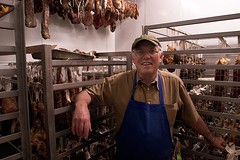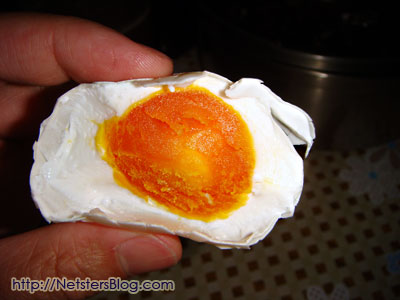
When I was a kid, I loved salami. If us kids were lucky, we’d get it sliced thin from the local deli and I’d stack it high with a ½ inch thick slab of cream cheese on white bread. A snack. Or else I’d just hack off giant hunks a salami, peel off the paper and eat them one after the other. And it was always Gallo Dry Salame (estranged younger brother of Ernest and Julio). It’s not like we had a choice; it was the only brand in town. Gallo Salame and Spam were pretty much all I knew about cured meat products for the first couple decades of my life.
Then in the early-90s, I became aware of the term charcuterie. You know, that trendy food craze that’s only been around since the 15 th century. I remember going to this Frenchy place in West Hollywood, Mimosa, and being dazzled by their charcuterie plate with its crock of mustard and the little cornichons. The rest of the food was not that remarkable but I’d never seen such a variety of pork products. Fat-speckled saucisson sec, aspic coated pâtés, pork rillettes, and other forcemeats I was too intimidated to ask about. I still don’t know much about French cured meats but that didn’t stop me from smuggling seven sausages when I went to the Dordogne a few years ago. La-di-da, aren’t I worldly?
These days, I never hear the word charcuterie. The new hip term seems to be salumi. Same thing, different country. And two names seem to be growing in ubiquity: the first is Paul Bertolli. A former executive chef at Chez Panisse, he latched onto Alice Waters’ slow food/local produce concept and pushed it to the geekiest levels. For example, he’s got a tasting database of 300+ tomato varieties and he mills his own flour for his pasta. I'm guessing he got beat up a lot as a kid. His book is amazing and also completely unrealistic for the home cook. I just don't see myself curing olives in lye anytime soon. But I’m glad that someone nerds out to the extent he does. He started curing his own meats in his restaurant basement for his restaurant, Oliveto, and then refined his techniques to where he created Fra’ Mani, a salumiere that distributes to restaurants and fancypants markets.

It’s very Whole Foods-y – sustainably raised pigs, no antibiotics, handcrafted, etc. Frankly, while it’s fantastic stuff, I haven’t had it enough to differentiate between their Salametto and the Salame Gentile and the Salame Toscano. They all have pork and salt and spices and wine and they all taste delicious. Clearly I need to eat more of it to appreciate their subtle differences. Please feel free to send me a gift order or two.
The other big name I keep hearing is the unimaginatively named Salumi Cured Meats. Started in Seattle by a retired aerospace engineer, they, too, adhere to traditional, artisanal techniques. They achieved prominence as the founder is the father and salumi provider of my culinary hero, Mario Batali. But make no mistake, its success is because of its dedication to quality, not nepotism. I’ve had everything from their guanciale, made from pig jowls, to their lardo, mouth-melting strips of pork fat and it’s all spectacular. But again, I think I need to sample much more of their offerings before I can truly make an informed judgment.
 Armandino Batali
Armandino Batali
I should emphasize that I'm kinda talking out my butt. I'm just a consumer who has done no actual market research. I have no idea if these salumieres are making an impact on anyone besides myself. But there is no denying that salume is a significant culinary trend. Just last month my sister brought me some stunning fennel pollen salame made at a hotel restaurant in Seattle. I’ve never tasted salami that was so bold and meaty and at the same time complex and subtly layered. It lasted maybe two days.
The other porcine revelation I had was when I tasted La Quercia prosciutto. I read about it in the New York Times and was skeptical. How could a product from Iowa be better than the Italian DOC-controlled original? But just like Napa’s Chateau Montelena beat out Bordeaux in 1976, La Quercia has been hailed as being better than its Old World counterparts. Herb and Kathy Eckhouse, basically smartypants academics, spent years learning the art of prosciutto curing in Parma before returning to the States to ply their trade.

Made from sustainably raised pigs – some from organic and Berkshire pigs (aka Kurobuta) – the meat is buttery and flavorful and the salumiere has a steady hand with the salt (the only other ingredient besides pork). The prosciutto slices are luscious; as sweet as they are salty. It is a completely different product than the overpriced, oversalted, German junk you get in the plastic packages at Trader Joe’s. Nothing against the Germans, but it’s a crime that they call that prosciutto.
So last weekend when my friends canceled dinner plans at the last second, I wasn't too bummed as I got to eat all the La Quercia prosciutto and Fra’ Mani Salame Toscano myself. Breakfast? Why not have a few shavings of salami? Afternoon snack? Why not have a couple slices of life-affirming prosciutto? And I’m not ashamed to say it: I chopped up the last three slices of prosciutto along with a handful of frozen peas to go with the Kraft mac & cheese I had for lunch. It was sublime.
 Your guess is as good as mine
If you were to look at my freezer, you’d think I was a really sloppy Mormon . In truth, I probably don’t have food for more than a couple weeks, but in those two weeks, I’d live like a goddamned king. I’ve got lamb stew, veggie chili, various meat stocks, frozen scallops, bacon, and tomato sauce, not to mention the dried goods – the saffron, chiles, porcini mushrooms and fermented black beans. My only issue is that I need to be more vigilant in labeling my foodstuffs. Too often, what I thought would be spaghetti Bolognese turned out to be brisket on noodles.
Your guess is as good as mine
If you were to look at my freezer, you’d think I was a really sloppy Mormon . In truth, I probably don’t have food for more than a couple weeks, but in those two weeks, I’d live like a goddamned king. I’ve got lamb stew, veggie chili, various meat stocks, frozen scallops, bacon, and tomato sauce, not to mention the dried goods – the saffron, chiles, porcini mushrooms and fermented black beans. My only issue is that I need to be more vigilant in labeling my foodstuffs. Too often, what I thought would be spaghetti Bolognese turned out to be brisket on noodles.
 No matter what the caption, you'll think salted duck eggs are disgusting but they're not. Honest
I think this hoarding behavior stems from my mother who used to keep stores of brandied fruit and salted duck eggs in the cupboards so us kids would never be wanting for (weird) food. The brandied fruit really sticks in my memory. It was stored in this very ‘70s smoky purple glass jar – a fermenting mass of various canned and fresh fruits every week by equal amounts of additional fruit and granulated sugar. We’d have it on ice cream or on pound cake; it was a convenient and handy way to make a pedestrian dessert instantly exotic. Or at least alcoholic.
As an adult, as I developed more of a taste for the savory over sweet, I decided to try keeping a store of duck confit. Basically, these are cured duck legs, cooked in duck fat and stored for several weeks in the fridge in duck fat. When done correctly, they are luscious, salty and gorgeous, with a fantastic depth of flavor that comes only from meats that are cured, cooked in fat and stored for several weeks in flavorful fat.
No matter what the caption, you'll think salted duck eggs are disgusting but they're not. Honest
I think this hoarding behavior stems from my mother who used to keep stores of brandied fruit and salted duck eggs in the cupboards so us kids would never be wanting for (weird) food. The brandied fruit really sticks in my memory. It was stored in this very ‘70s smoky purple glass jar – a fermenting mass of various canned and fresh fruits every week by equal amounts of additional fruit and granulated sugar. We’d have it on ice cream or on pound cake; it was a convenient and handy way to make a pedestrian dessert instantly exotic. Or at least alcoholic.
As an adult, as I developed more of a taste for the savory over sweet, I decided to try keeping a store of duck confit. Basically, these are cured duck legs, cooked in duck fat and stored for several weeks in the fridge in duck fat. When done correctly, they are luscious, salty and gorgeous, with a fantastic depth of flavor that comes only from meats that are cured, cooked in fat and stored for several weeks in flavorful fat. This isn't the actual spice mix (it's one for bacon), but it's a pretty picture, no?
Recipes abound. But the key elements are: cure the duck for a day or so in salt and very aromatic herbs, cook the duck in duck fat for a couple hours at a low heat, then store in the same duck fat in the fridge for at least a couple weeks. In my herb mix, I used coriander seeds, pepper, bay leaves and Szechuan chili peppers known for their distinct flavor and tongue numbing qualities. In the final result, the numbing effect was deadened, but the distinct floral-herbaceous notes were very present.
This isn't the actual spice mix (it's one for bacon), but it's a pretty picture, no?
Recipes abound. But the key elements are: cure the duck for a day or so in salt and very aromatic herbs, cook the duck in duck fat for a couple hours at a low heat, then store in the same duck fat in the fridge for at least a couple weeks. In my herb mix, I used coriander seeds, pepper, bay leaves and Szechuan chili peppers known for their distinct flavor and tongue numbing qualities. In the final result, the numbing effect was deadened, but the distinct floral-herbaceous notes were very present.
 Duck cooked in duck fat now crisped in duck fat. Jon Cryer beware
But the biggest obstacle was keeping the duck legs in the fridge without eating them. While most recipes say that the legs will keep for up to a month, I read somewhere that Nancy Silverton (or was it Alice Waters? How embarrassing, but seriously, all you white women chefs look alike to me) liked to serve duck confit after three months or longer, as the legs become more tender and complex in flavor.
Duck cooked in duck fat now crisped in duck fat. Jon Cryer beware
But the biggest obstacle was keeping the duck legs in the fridge without eating them. While most recipes say that the legs will keep for up to a month, I read somewhere that Nancy Silverton (or was it Alice Waters? How embarrassing, but seriously, all you white women chefs look alike to me) liked to serve duck confit after three months or longer, as the legs become more tender and complex in flavor.
 Alice Waters, Nancy Silverton, clearly separated at birth
I managed to wait three months at which point I served mine over blanched Brussels sprout leaves with a really gummy and lousy mustard/blueberry sauce. But any flaws in the presentation were mitigated by the reheating of the duck legs – crisped in their own fat to a golden brown on both sides. In my mind, this is the best way to serve them though you can also use them in a cassoulet or shredded on pizza or in stuffed pasta or some other chi-chi preparation. In the crispy incarnation, the sauce and bedding become completely cosmetic and superfluous. It's hard to go wrong.
Alice Waters, Nancy Silverton, clearly separated at birth
I managed to wait three months at which point I served mine over blanched Brussels sprout leaves with a really gummy and lousy mustard/blueberry sauce. But any flaws in the presentation were mitigated by the reheating of the duck legs – crisped in their own fat to a golden brown on both sides. In my mind, this is the best way to serve them though you can also use them in a cassoulet or shredded on pizza or in stuffed pasta or some other chi-chi preparation. In the crispy incarnation, the sauce and bedding become completely cosmetic and superfluous. It's hard to go wrong. Please ignore the gooey smudge in the background
The crisped legs were truly gorgeous, if I do say so myself. I’m sure some native from the Dordogne would scoff at my Asian treatment of the duck, but that was my choice. I’m Chinese. Bite me, François. I’d encourage readers to ignore the Frenchies use their own spice mix. It's really not that hard yet it's something you'll never get in a restaurant because, in general, they can't afford to keep food that long. Your results may vary but if you find a combo that works, please post.
Please ignore the gooey smudge in the background
The crisped legs were truly gorgeous, if I do say so myself. I’m sure some native from the Dordogne would scoff at my Asian treatment of the duck, but that was my choice. I’m Chinese. Bite me, François. I’d encourage readers to ignore the Frenchies use their own spice mix. It's really not that hard yet it's something you'll never get in a restaurant because, in general, they can't afford to keep food that long. Your results may vary but if you find a combo that works, please post.


